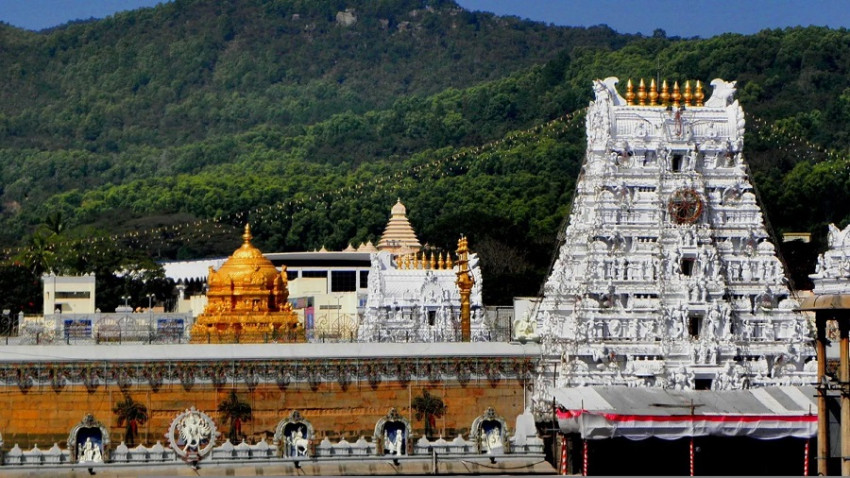
The southern states of India, including Tamil Nadu, Karnataka, Kerala, and Andhra Pradesh, hold a plethora of temples as part of the enchanting South India Temple Tour. These temples have been centers of devotion, art, and culture for centuries, forming an integral aspect of this captivating journey. They are not just places of worship; rather, they are living reflections of the region's rich history and beliefs. Pilgrims and tourists alike are drawn to embark on this architectural and spiritual odyssey, seeking both profound spiritual solace and a captivating glimpse into India's illustrious past.
The Magnificent Meenakshi Amman Temple
One of the most iconic temples in Madurai, the Meenakshi Amman Temple, dedicated to Goddess Parvati, is a marvel of Dravidian architecture. Its towering gopurams (entrance towers) are adorned with intricate sculptures depicting mythological stories, and its sprawling complex comprises various halls, shrines, and tanks. The temple is an embodiment of the Chola, Pandya, and Nayaka architectural styles, showcasing the intricate craftsmanship of the past.
Brihadeeswarar Temple: Chola Grandeur Unveiled
Built by the Chola emperor Raja Raja I, the Brihadeeswarar Temple in Thanjavur is a UNESCO World Heritage Site and a masterpiece of the Chola dynasty's artistic and architectural prowess. Its towering vimana (temple tower) is a remarkable feat of engineering, constructed without the use of mortar. The temple complex houses an imposing Nandi statue, and its walls are adorned with intricately carved sculptures that narrate stories from Hindu mythology.
Airavatesvara Temple: A World of Intricate Sculptures
The Airavatesvara Temple in Darasuram is renowned for its stunning sculptures that narrate tales from Hindu mythology. This UNESCO World Heritage Site is a treasure trove of art, with its pillars, walls, and ceilings adorned with intricate carvings. The temple's unique architecture and the presence of a massive stone chariot make it a prime example of the artistic brilliance of the Chola dynasty.
Ramanathaswamy Temple: A Sacred Bathing Pilgrimage
Located on the serene island of Rameshwaram, the Ramanathaswamy Temple is famous for its sacred wells and the belief that a dip in the holy waters can cleanse one's sins. The temple's long corridor, known as the "Pillars of Ramanathaswamy," is adorned with intricate carvings that depict various deities and stories from Hindu scriptures. Pilgrims flock here not only for its spiritual significance but also to marvel at the stunning architecture.
Shore Temple: Where Art Meets the Bay of Bengal
A UNESCO World Heritage Site in Mahabalipuram, the Shore Temple stands as a symbol of the region's maritime heritage. Carved from granite, this temple is dedicated to both Lord Shiva and Lord Vishnu. Its unique pyramidal structure, intricately carved reliefs, and proximity to the Bay of Bengal make it a site of unparalleled beauty, especially during sunrise and sunset.
Virupaksha Temple: Celebrating Life in Stone City
As the heart of Hampi's ruins, the Virupaksha Temple has stood for centuries as a witness to the grandeur of the Vijayanagara Empire. The temple's intricate carvings, majestic gopuram, and annual chariot festival draw devotees and tourists alike. The Virupaksha Temple's vibrant history and the vibrant bazaar surrounding it create an immersive experience that transports visitors back in time.
Badami Cave Temples: Rock-Cut Wonders of Karnataka
Carved into the sandstone hills of Badami, the Badami Cave Temples are a remarkable fusion of art and spirituality. These rock-cut caves are a testament to the architectural brilliance of the Chalukya dynasty. Each cave is dedicated to a different deity and adorned with intricate sculptures that depict scenes from Hindu mythology. The temples are a living canvas that showcases the artistic excellence of ancient India.
Tirupati Balaji Temple: Where Divinity Meets Devotion
The Tirumala Venkateswara Temple in Tirupati is one of the most visited religious sites globally, attracting millions of devotees annually. The temple's deity, Lord Venkateswara, is believed to bestow blessings and fulfill wishes. Devotees undertake a rigorous pilgrimage to reach the temple atop the Tirumala hills, where they offer prayers and witness the stunning architecture that harmoniously blends tradition and spirituality.
Murudeshwar Temple: Lord Shiva and the Arabian Sea
With the Arabian Sea as its backdrop, the Murudeshwar Temple in Karnataka houses the world's second-largest statue of Lord Shiva. The temple's breathtaking location and towering gopuram make it a must-visit for both devotees and tourists. The temple complex also features a towering Raja Gopuram, intricate carvings, and a serene beach, creating a serene atmosphere for spiritual contemplation.
Kanchipuram's Ekambareswarar Temple: A Forest of Pillars
Dedicated to Lord Shiva, the Ekambareswarar Temple in Kanchipuram is renowned for its "Hall of 1,000 Pillars," each intricately carved with mythological figures and divine beings. The temple's sacred mango tree, believed to be hundreds of years old, adds to its aura. The Ekambareswarar Temple is a testament to the Dravidian architectural style and its intricate detailing that continues to mesmerize visitors.
Madurai's Koodal Azhagar Temple: Blend of Divinity and Art
This temple is a testament to the blend of art and devotion that Madurai is known for. The Koodal Azhagar Temple's intricate sculptures and the portrayal of Lord Vishnu in various forms make it a living museum of Hindu mythology. The temple's ornate carvings and vibrant paintings tell stories of devotion, dharma, and cosmic balance, captivating all who enter its premises.
The Ancient Shore Temples of Mahabalipuram
Carved out of rock, the Shore Temples of Mahabalipuram are a UNESCO World Heritage Site and showcase the Pallava dynasty's architectural finesse. These temples, perched by the sea, tell stories of the past through intricate carvings that depict scenes from the Mahabharata and Ramayana. The Shore Temples are not just architectural marvels but also historical narratives etched in stone.
Rameshwaram: The Spiritual Island of Rama's Feats
Rameshwaram's significance in the Ramayana epic makes it a place of deep reverence for Hindus. The Ramanathaswamy Temple's 22 sacred wells and the belief that Lord Rama consecrated the lingam here add to its mystique. The temple's grand corridors, elaborate sculptures, and the view of the azure ocean create an atmosphere of spiritual contemplation and awe.
Chidambaram Temple: Nataraja's Cosmic Dance
Dedicated to Lord Shiva's Nataraja form, the Chidambaram Temple is a center of spirituality and art. The temple's architecture symbolizes the cosmic dance of creation and destruction, known as the Ananda Tandava. The presiding deity, Nataraja, is enshrined in the sanctum sanctorum, inviting devotees to witness the divine dance that represents the rhythm of life.
Thillai Nataraja Temple: Portal to an Ethereal Realm
Known for its ornate beauty, the Thillai Nataraja Temple in Chidambaram is a celebration of art and divinity. The temple's sanctum represents the Chidambaram Rahasyam, where Lord Shiva is believed to perform the Ananda Tandava. The temple's vibrant festivals, intricate architecture, and cultural significance make it a spiritual destination for seekers of all kinds.
Kanyakumari Temple: Where Oceans Merge in Devotion
At the southernmost tip of India, the Kanyakumari Temple stands as a symbol of devotion and unity. Dedicated to the goddess Kanyakumari, this temple's location at the confluence of the Arabian Sea, the Bay of Bengal, and the Indian Ocean adds to its significance. The temple's architecture and serene surroundings create a tranquil atmosphere for introspection and worship.
Palani Murugan Temple: Journey to Lord Murugan's Abode
Perched atop a hill in Palani, the Palani Murugan Temple is dedicated to Lord Murugan, the warrior god. Devotees climb the steps to reach the temple, seeking the blessings of Murugan, who is believed to protect them from hardships. The temple's architecture, panoramic views, and the devotion of the pilgrims make it a spiritual and visual delight.
Suchindram Thanumalayan Temple: An Architectural Marvel
The Suchindram Thanumalayan Temple is a unique blend of Hindu, Tamil, and Dravidian architectural styles. It houses a towering 22-foot statue of Lord Anjaneya and is dedicated to the Trimurti—Lord Brahma, Lord Vishnu, and Lord Shiva. The temple's intricate carvings, musical pillars, and stunning gopurams showcase the artistic and spiritual heritage of the region.
Lepakshi Veerabhadra Temple: Hanging Pillar Mystery
The Lepakshi Veerabhadra Temple in Andhra Pradesh is renowned for its suspended pillar, a remarkable architectural feat that has intrigued visitors for centuries. The temple's intricate carvings, mural paintings, and monolithic structures are a testament to the Vijayanagara architectural style. The temple's artistic brilliance and the mystery of the hanging pillar make it a site of wonder.
Hampi's Hazara Rama Temple: Ramayana Carvings in Stone
The Hazara Rama Temple in Hampi narrates the epic tale of the Ramayana through its intricate carvings. The temple's outer walls are adorned with detailed reliefs that depict scenes from Lord Rama's life. These carvings not only showcase the architectural excellence of the Vijayanagara Empire but also serve as a visual retelling of the Ramayana, inspiring devotion and awe.
Conclusion: A Tapestry of Spiritual Marvels
South India's Hindu temples stand as monuments to devotion, culture, and architectural brilliance. Each temple weaves a unique story of faith, art, and history. From the intricately carved sculptures to the towering gopurams that touch the heavens, these temples continue to draw visitors from around the world, offering them a glimpse into the spiritual soul of South India.
FAQs
Are these temples open to tourists of all faiths? Yes, these temples welcome visitors of all faiths who wish to admire their architecture and learn about their cultural significance.
Can I take photographs inside the temples? Photography regulations vary from temple to temple. Some temples allow photography in certain areas, while others may have restrictions. It's advisable to check with the temple authorities beforehand.
Are there specific dress codes for temple visits? Many temples have dress codes that require visitors to dress modestly, covering shoulders and knees. It's recommended to wear traditional attire or clothing that adheres to the temple's guidelines.
What is the significance of the hanging pillar in Lepakshi Temple? The hanging pillar in Lepakshi Veerabhadra Temple is an architectural marvel where the pillar's base doesn't touch the ground fully. This mystery has fascinated visitors for centuries, showcasing the advanced engineering skills of ancient artisans.
Are these temples accessible by public transportation? Most of these temples are accessible by various modes of transportation. Some may require additional travel, such as climbing hills or crossing rivers, to reach the temple premises.






